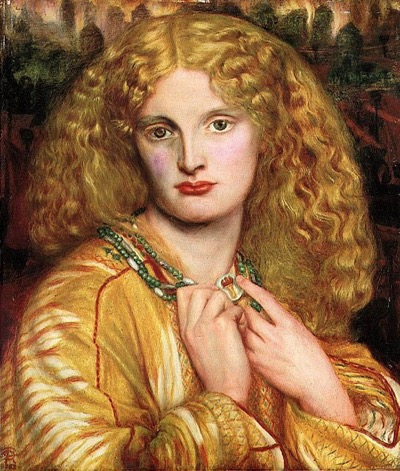As the "face that launched a thousand ships," Dante Gabriel Rossetti's depiction of Helen of Troy encapsulates many of the themes and motifs that were popular in the late 19th century. Painted with oil on panel in 1863, Helen of Troy is inspired by the Pre-Raphelite Sisterhood movement.
While this work bears similarities with some of Rossetti’s other works, such as his poem "Troy Town," it's also been criticised in his time by Frederick Sandys, who argued that Rossetti's Helen was too similar to his own work. The symbology and meaning behind the work are straightforward. The canvas prominently displays the portrait of Annie Miller, the model used as Helen of Troy, front and centre. Her golden, curled locks of hair complement her large golden-coloured garment.
Around her neck is a pendant bearing a firebrand, which she points to with her left index figure. This symbolises her adulterous lover, Paris, who snatched her from her husband Menelaus, thus igniting the decade-long Trojan War. Behind Helen in the background, one can clearly see fire, which displays the burning down of Troy. The rich greens of the burning trees in the background contrast with the rich and vibrant golden-yellow colours of Helen. Light green is also used on the pendant as well as in Helen's hair. Rossetti’s choice of red is also a pleasant balance to the predominant greens and yellows used. It can be found in the background as the red earth, and more vibrantly as her lipstick as well as for red threads running along her garment and on her cuffs.
Helen's look seems to be of anxiety and lament for the loss of her lover and her inevitable return to her husband, the Lacedaemonian ruler Menelaus. The Greek tragedian Aeschylus recounts the fate of Menelaus' brother Agamemnon, commander of the expedition to Troy, in his trilogy Oresteia, namely the Agamemnon. Inscriptions from the Agamemnon can be found behind the portrait in Greek, describing Helen as the cause of the destruction of ships, men, and cities. Rossetti’s choice of Helen as the subject for this work reflects the rise in hellenophilia of the late 19th century and the subsequent appreciation for the epic poetry of the Trojan War's importance in the Western tradition. This work is currently located in the Kunsthalle (art hall), in Hamburg, Germany.




